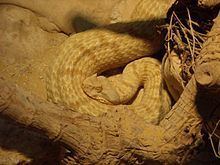Kingdom Animalia Suborder Serpentes Subfamily Viperinae Phylum Chordata Rank Subspecies | Subphylum Vertebrata Family Viperidae Genus Pseudocerastes Higher classification Pseudocerastes persicus Order Scaled reptiles | |
 | ||
Scientific name Pseudocerastes persicus fieldi Similar Pseudocerastes, Snake, Vipers, Reptile, Echis coloratus | ||
field s horned viper pseudocerastes persicus fieldi
Pseudocerastes persicus fieldi is a venomous viper subspecies endemic to the deserts of the Middle East. The main differences between this subspecies and the nominate race are in scalation and venom composition.
Contents
- field s horned viper pseudocerastes persicus fieldi
- Etymology
- Description
- Geographic distribution
- Venom
- Taxonomy
- References
Etymology
The subspecific name, fieldi, is in honor of American anthropologist Henry Field, who collected the holotype. The Field Museum of Natural History in Chicago and its scientific publication, Fieldiana, in which K.P. Schmidt's original description of this viper appeared, are named for Henry Field's grandfather, Marshall Field.
Description
Outwardly, P. p. fieldi differs from P. p. persicus in certain (lower) scale counts:
Additional differences from P. p. persicus include much shorter (relatively to the overall body length) tail as well as the fact that while in P. p. persicus all dorsal and lateral scales are strongly keeled, P. p. fieldi has several rows of almost smooth lateral scales.
Geographic distribution
According to McDiarmid et al. (1999) P. p. fieldi is found in the Sinai Peninsula, Israel, Jordan, northern Saudi Arabia, northwestern Iraq, and possibly in southern Syria.
The type locality given in the original description is "Bair Wells, Transjordania" [Jordan].
According to Mallow et al. (2003) it is found in the Sinai Peninsula, southern Israel, Jordan, extreme northern Saudi Arabia, and southwestern Iraq.
Venom
There is a more pronounced difference between the two subspecies with regard to their venom. While P. p. persicus venom exhibits strong hemorrhagic activity typical of most vipers, the venom of P. p. fieldi is unusual in that contains several fractions that show marked neurotoxic activity. No antivenin is available for bites from either subspecies. It is reported that a polyvalent antiserum does offer some protection from the hemotoxins, but none against the neurotoxic effects of P. p. fieldi venom.
Taxonomy
Some sources elevate P. p. fieldi to species level. The first phylogenetic study of the genus Pseudocerastes, published by Fathinia et al. in 2014, shows that P. p. fieldi has equal genetic distance from both P. p. persicus and another species of the same genus, P. urarachnoides.
